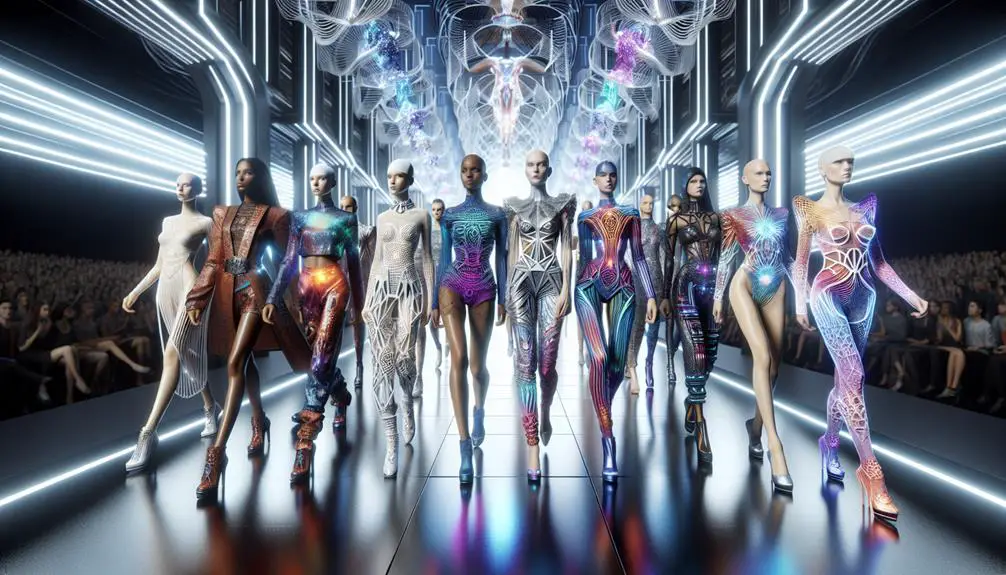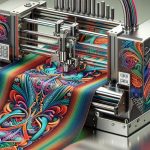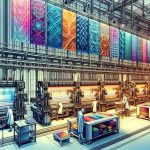You might say the fashion world is experiencing a bit of a shake-up with the arrival of 3D printed fabrics. These innovative textiles offer designers a way to push boundaries without the constraints of traditional methods. Imagine being able to create intricate, customizable patterns that not only reduce waste but also utilize renewable resources. It's not just about aesthetics; it's about sustainability and efficiency. Curious about how this technology can reshape the future of clothing production? Let's explore the potential and implications that 3D printing brings to fashion.
Table of Contents
Key Takeaways
- 3D printed fabrics offer unparalleled design flexibility, enabling intricate patterns and innovative textures.
- The technology significantly reduces material waste and energy consumption, promoting sustainable fashion practices.
- Biodegradable and plant-based printing materials align with the growing consumer demand for eco-friendly products.
- Custom-fit and on-demand production ensure personalized, perfect-fit garments while minimizing overproduction.
- Advanced 3D printing techniques push the boundaries of traditional fashion with versatile and complex designs.
History of 3D Printed Fabrics
The history of 3D printed fabrics dates back to the early 2010s when designers began experimenting with this innovative technology. You'll find that the evolution of technology in 3D printing has been nothing short of revolutionary for the fashion industry. Initially, it was all about pushing boundaries and seeing what was possible.
Early adopters in the fashion world were captivated by the potential to create intricate patterns and structures that traditional methods couldn't achieve. As technology advanced, so did its applications in fashion. By integrating computer-aided design (CAD) and additive manufacturing, designers were able to produce textiles with unprecedented precision and complexity.
The fashion industry's adoption of 3D printing wasn't just a fleeting trend; it signaled a significant shift towards more sustainable and customized clothing options. Complex, geometrically intricate designs that were once only theoretical became tangible realities.
You'll notice that major fashion houses and avant-garde designers alike began showcasing 3D printed pieces on runways, propelling the technology into the mainstream. This marriage between cutting-edge technology and high fashion has set the stage for further innovations, making 3D printed fabrics a cornerstone in the future of fashion design.
How 3D Printing Works
Diving into the mechanics, you'll find that 3D printing transforms digital designs into physical objects by layering material in precise patterns. This printing process begins with a digital model, often created using CAD (Computer-Aided Design) software. The model is then sliced into thin horizontal layers, each representing a cross-section of the final object.
The 3D printer meticulously builds the object layer by layer, following the digital blueprint.
Key points to understand the operation of 3D printing:
- Layering Technology: The core mechanism involves depositing material layer by layer, which can include plastics, metals, or even advanced polymers.
- Precision: Each layer is typically less than a millimeter thick, allowing for intricate and highly detailed designs.
- Material Choices: Depending on the application, different materials can be used, expanding the design possibilities.
- Speed and Efficiency: Modern 3D printers can rapidly produce complex designs, reducing traditional manufacturing times to a great extent.
- Customization: The ability to easily modify digital models offers unparalleled creative freedom.
Benefits for Designers
Understanding how 3D printing works opens up a world of benefits for designers, providing unparalleled flexibility and innovation opportunities. You can transform your creative visions into tangible realities more effortlessly than ever before. The technology allows you to experiment with intricate patterns, complex textures, and unique shapes that would be nearly impossible to achieve through traditional methods.
One major advantage is the cost-effective solutions that 3D printing offers. You can produce exact prototypes and final products without the need for expensive molds or excessive material waste. This efficiency not only reduces production costs but also shortens the time it takes to bring your designs from concept to completion. You can iterate quickly, making adjustments on the fly, which is invaluable in a fast-paced industry.
Additionally, 3D printing grants you extraordinary creative freedom. You're not confined by the limitations of conventional fabrics and manufacturing techniques. Whether you're crafting avant-garde couture or functional wearables, the only boundaries are those set by your imagination. By leveraging this technology, you can push the envelope of fashion design, creating pieces that are as innovative as they're visually stunning.
Embracing 3D printing propels you to the forefront of the fashion world, where creativity knows no bounds.
Sustainability and Eco-Friendliness
When you explore 3D printed fabrics, you'll notice their significant benefits for sustainability. These fabrics reduce material waste, use energy-efficient production methods, and often incorporate biodegradable printing materials.
Reduced Material Waste
One of the standout benefits of 3D printed fabrics is their ability to reduce material waste by a large margin, making them a sustainable and eco-friendly option. By leveraging advanced material efficiency, you can cut down significantly on excess fabric that typically ends up in landfills. This process guarantees that every inch of material is utilized, aligning perfectly with cost-effectiveness and environmental impact goals.
Imagine how much you could achieve with design flexibility that 3D printing offers. You're not bound by the limitations of traditional textile manufacturing, allowing you to create intricate designs without generating unnecessary waste.
Here are key advantages:
- Precision Manufacturing: Only the required amount of material is used, eliminating offcuts.
- Custom Fit: Tailor-made designs guarantee minimal waste and maximum comfort.
- Resource Optimization: Efficient use of raw materials reduces the need for excess inventory.
- Reduced Overproduction: On-demand production minimizes surplus.
- Sustainable Practices: Lower waste means fewer environmental repercussions.
Energy-Efficient Production
3D printed fabrics offer a more energy-efficient production process, drastically lowering the carbon footprint compared to traditional textile manufacturing. When you adopt 3D printing, you're leveraging innovative technology that minimizes energy usage.
Traditional textile production consumes significant energy, from spinning yarn to operating large looms and dyeing fabrics. In contrast, 3D printing employs precise resource conservation, using only the material needed for each design. This approach reduces energy consumption by eliminating unnecessary steps and waste.
By focusing on sustainable manufacturing, you're addressing the broader environmental impact of the fashion industry. 3D printing enables you to create complex patterns and textures with less energy, making it a game-changer in eco-friendly design.
You can produce customized, on-demand garments without the excessive energy expenditure associated with mass production. Additionally, this technology allows for localized production, cutting down on the energy used for transportation and logistics.
Embracing 3D printed fabrics means you're not just innovating; you're actively contributing to a more sustainable future. The energy savings achieved through this method have far-reaching implications for reducing the overall carbon footprint of fashion, aligning with your commitment to environmental stewardship.
Biodegradable Printing Materials
Building on the energy efficiency of 3D printed fabrics, incorporating biodegradable printing materials takes sustainability to the next level. Imagine a world where your cutting-edge fashion pieces leave no lasting environmental impact. By using biodegradable materials like PLA (polylactic acid) derived from renewable resources, designers can craft garments that not only look stunning but also decompose naturally, reducing waste.
In the fashion industry, meeting consumer demand for eco-friendly options is essential. Biodegradable materials offer new design possibilities while answering the call for sustainability. These fabrics can be customized with intricate patterns and textures, pushing the boundaries of traditional fashion.
Here's why biodegradable printing materials are game-changers:
- Reduced Waste: Garments break down naturally, lessening landfill accumulation.
- Lower Carbon Footprint: Production processes consume fewer resources.
- Renewable Resources: Materials like PLA come from plants, making them more sustainable.
- Versatile Designs: Adaptable to complex shapes and patterns.
- Consumer Appeal: Satisfies the growing demand for eco-friendly fashion.
Innovations in Textures and Patterns
By harnessing advanced 3D printing technology, designers are creating fabrics with unprecedented textures and intricate patterns. This innovation allows you to explore textile manipulation in ways that were once unimaginable.
Imagine having the power to redefine the very fabric of fashion by integrating creative possibilities that push the boundaries of traditional design. You can now produce materials that mimic organic structures, geometric shapes, or even abstract art, all with impeccable precision.
Surface embellishment has also reached new heights, thanks to these innovative techniques. No longer are you confined to flat, two-dimensional designs. With 3D printing, you can add depth and dimension to your fabrics, making them as visually striking as they're tactilely engaging.
Whether it's through raised patterns, intricate lacework, or complex weaves, the options are virtually limitless.
When you embrace these cutting-edge methods, you not only enhance the aesthetic appeal of your creations but also give them a unique, handcrafted quality. This dual benefit of functionality and artistry is what sets 3D printed fabrics apart in the fashion industry.
Custom-Fit and Personalization
Taking the leap from innovative textures and patterns, you can now tailor 3D printed fabrics to fit individual body shapes and personal preferences with unmatched precision. This isn't just a trend; it's a revolutionary shift enabled by technology advancements.
Imagine garments that fit you like a second skin, designed explicitly for your measurements and style choices. With 3D printed fabrics, customization isn't a luxury—it's the standard.
Consider the benefits of this technology:
- Perfect Fit: Every curve and contour of your body is considered, ensuring a flawless fit.
- Unique Designs: Your wardrobe can reflect your personal style more accurately than ever before.
- Sustainability: Custom-fit means less waste, as garments are produced on demand and tailored to individual needs.
- Durability: 3D printed fabrics can be engineered for strength and longevity, reducing the need for frequent replacements.
- Accessibility: This technology can democratize fashion, making high-quality, custom-fit clothing available to a broader audience.
Future Trends in Fashion Design
As 3D printing technology evolves, the fashion industry is poised to embrace groundbreaking trends that will redefine how we create and wear clothing. You'll see the rise of virtual fashion, where digital garments can be tried on in augmented reality before purchasing. This not only minimizes waste but also allows for a highly personalized shopping experience.
Imagine browsing through a virtual closet, selecting outfits that fit your exact measurements and style preferences, all without stepping into a physical store.
Tech-infused designs are another exciting trend. These garments will integrate advanced materials and embedded electronics, offering functionalities beyond aesthetics. You'll have clothing that can change color based on your environment or monitor your health metrics in real-time.
Think of jackets that can heat up during cold weather or dresses that illuminate in the dark, all made possible by 3D printing's precision and versatility.
Customization will reach new heights, enabling designers to experiment with complex structures and sustainable materials. You'll be able to order bespoke pieces tailored to your unique body shape and preferences, making fashion more inclusive and environmentally friendly.
The future of fashion design isn't just about looking good; it's about smart, sustainable, and personalized innovation.
Frequently Asked Questions
What Materials Are Commonly Used in 3D Printed Fabrics?
You're wondering what materials are commonly used in 3D printed fabrics. You'll find that Polyester and Nylon are popular choices. They're both durable and versatile, making them ideal for innovative and high-quality fabric designs.
How Durable Are 3D Printed Fabrics in Everyday Wear?
You'll find 3D printed fabrics offer impressive longevity and versatility. With proper maintenance, they're practical for everyday wear. Their sustainability also adds value, making them a smart choice for those who prioritize both fashion and function.
Can 3D Printed Fabrics Be Washed Like Traditional Textiles?
Yes, you can wash 3D printed fabrics, but you should follow specific washing instructions to guarantee longevity and sustainability. Proper maintenance will help preserve their unique properties and extend their lifespan, making them viable for everyday use.
What Are the Costs Associated With Producing 3D Printed Fabrics?
When conducting a cost analysis, you'll find production expenses for 3D printed fabrics include material costs, printer maintenance, and design software fees. These factors combined can make it pricier than traditional methods, but innovation often justifies the investment.
How Do 3D Printed Fabrics Compare to Traditional Fabrics in Terms of Comfort?
When comparing comfort, 3D printed fabrics excel in breathability and flexibility but can lag in wearability. Traditional fabrics often offer better movement and stretchiness, making them more comfortable for daily use.
- How Does Ring Spun Cotton Affect Garment Fit and Shape Retention? - August 13, 2024
- What Are the Challenges in Producing Ring Spun Cotton? - August 13, 2024
- Is Ring Spun Cotton Suitable for Plus-Size Clothing? - August 13, 2024







